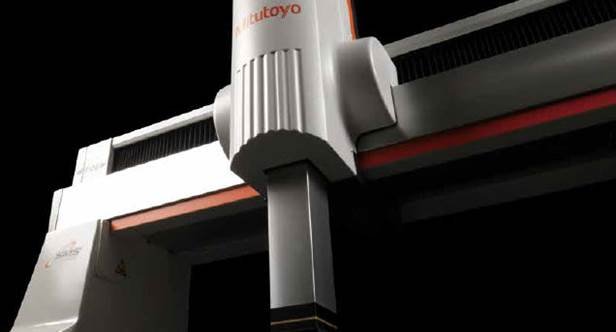Why 3D Comparative Gages Fall Short in Quality Inspections Compared to Modern CMMs
By Gene Hancz | Mitutoyo CMM Product Manager
In modern manufacturing environments, precision and efficiency are critical—not only during production but also in the inspection process. To maintain high standards of quality and compliance, manufacturers increasingly rely on automated measurement systems. Among these, 3D comparative gages have become popular due to their speed, ease of use, and flexibility on the shop floor. These systems operate by comparing production parts to a pre-qualified master part, offering quick go/no-go feedback. However, despite their convenience, comparative gages have significant limitations that make them unsuitable for final quality inspections, especially when compared to today’s advanced coordinate measuring machines (CMMs).
A fundamental issue with 3D comparative gages is their reliance on relative measurement. Instead of capturing absolute dimensions, these systems detect only deviations from a single master part. This means the accuracy of every subsequent measurement depends entirely on the condition and correctness of that master. If the master part is slightly worn, damaged, or improperly verified, every measurement will be skewed. There is no built-in mechanism to ensure long-term reliability, and no traceability to certified standards.
Another critical drawback is that 3D comparative gages do not provide an ISO accuracy statement and are not accredited to any recognized calibration standard. This lack of formal metrology certification means the measurement results cannot be independently verified or trusted in regulated inspection environments. Without a declared uncertainty or traceability to international standards, the data generated is effectively informal—unsuitable for audit, compliance, or certification.
Additionally, comparative gages are highly sensitive to environmental changes. Shop floor conditions—such as fluctuations in temperature, vibration, and humidity—can directly affect measurement accuracy. These systems lack real-time temperature compensation, making them particularly vulnerable to thermal drift. As a result, they require frequent re-mastering to maintain even minimal accuracy. This process not only introduces downtime but also adds risk of human error, ultimately slowing productionrather than streamlining it.
In contrast, modern CMMs provide a solution that directly addresses these shortcomings. Designed for high-accuracy measurement, CMMs offer certified traceability to ISO standards, ensuring that each dimension recorded is absolute, verifiable, and audit-ready. This level of precision is essential in industries governed by strict regulatory standards, such as aerospace, automotive, and medical device manufacturing.
CMMs also excel in handling real-world parts, thanks to their larger, cubic measurement volume. Whether inspecting small, machined components or large castings, a CMM provides the flexibility and reach required without compromising on accuracy. Moreover, the latest shop floor CMMs are built withtemperature compensation and environmental durability, enabling them to operate reliably in uncontrolled manufacturing environments with minimal setup or downtime.
Where comparative gages rely on manual programming or limited routine setups, CMMs benefit from advanced graphical software interfaces and CAD-driven offline programming. This allows operators to create inspection routines directly from digital part models, reducing setup time and minimizing operator intervention. These tools also provide intuitive, visual reporting and data export options, which are invaluable for quality documentation and regulatory audits.
Speed is no longer a compromise with CMMs. Today's systems feature faster movement and high-speed probing, significantly increasing throughput while maintaining micron-level accuracy. The integration ofreal-time thermal compensation ensures that accuracy is maintained even as environmental conditions shift—without the need for re-mastering. This not only improves reliability but also contributes to leaner, more efficient operations.
Another key advantage is full compliance with industry-specific quality systems. CMMs are built and certified to meet the documentation, repeatability, and traceability requirements mandated in sectors like aerospace and medical manufacturing. Comparative gages, by contrast, simply do not meet these standards. Their measurements are not traceable, cannot be audited independently, and do not satisfy the rigorous inspection protocols required by most regulatory bodies.
In summary, while 3D comparative gages offer quick and convenient checks during production, they should not be used as primary inspection tools for quality assurance. Their lack of absolute measurement, environmental sensitivity, need for constant re-mastering, absence of ISO-certified accuracy, and inability to provide certified traceability make them ill-suited for formal inspection roles.
Modern CMMs, on the other hand, deliver precision, reliability, and compliance with the added benefits of faster throughput, robust software integration, and environmental resilience. For manufacturers who are serious about quality—and who need inspection processes that can stand up to audits and customer scrutiny—CMMs remain the superior choice.
Where and Why 3D Comparative Gages Should Not Be Used:
· Final Quality Inspections: They lack traceable, absolute dimensional data required for certification and compliance with quality standards.
· Regulated Industries: In aerospace, medical, and automotive sectors, where documentation and auditability are essential, comparative gages do not meet compliance requirements.
· Variable Shop Floor Environments: Without temperature compensation, they are sensitive to environmental changes, leading to inaccurate readings.
· Applications Requiring Statistical Process Control (SPC): They cannot provide the absolute data necessary for SPC analysis or capability studies.
· Parts with Complex Geometries or Large Dimensions: Their limited measurement volume and probing capability make them unsuitable for complex or oversized parts.
· High-Accuracy Requirements: Their reliance on a master part and susceptibility to drift make them unreliable for tight-tolerance measurements.
· Environments Demanding Minimal Downtime: The need for constant re-mastering interrupts workflow and reduces overall efficiency.
· Audit-Ready Documentation: They do not generate the detailed, certified reports that modern quality systems require.
· ISO or Calibration-Critical Applications: They do not offer an ISO accuracy statement and are not accredited to any international calibration standard.

